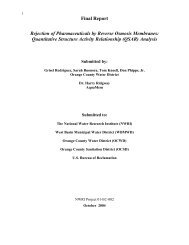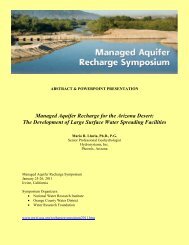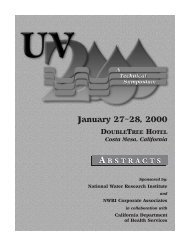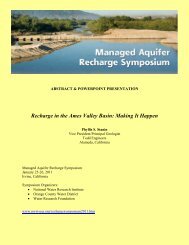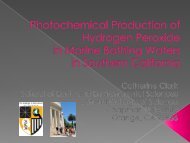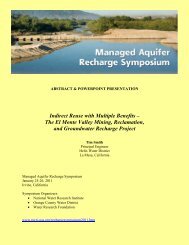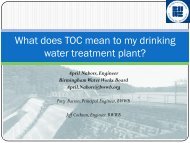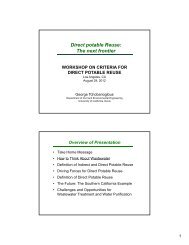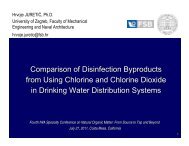RBF_Cover (for eps) - National Water Research Institute
RBF_Cover (for eps) - National Water Research Institute
RBF_Cover (for eps) - National Water Research Institute
You also want an ePaper? Increase the reach of your titles
YUMPU automatically turns print PDFs into web optimized ePapers that Google loves.
138<br />
experiments. Most of the hydrophilic compounds under investigation are industrial chemicals<br />
with high production volumes and a broad range of applications; there<strong>for</strong>e, they are likely to enter<br />
river water if they are not totally removed in industrial or municipal wastewater treatment plants.<br />
In this paper, data on their fate during <strong>RBF</strong> will be presented, whereby the results of both lab-scale<br />
experiments and long-time measurements of river water and bank-filtrated water will be given.<br />
For the simulation of microbial degradation during <strong>RBF</strong>, a so-called “test filter” is used. This<br />
closed-loop apparatus was developed and used by Sontheimer and Völker (1987) <strong>for</strong> the<br />
characterization of fractions of surrogate parameters from wastewater effluents. In the last few<br />
years, the method was adjusted and optimized to study the biodegradation of single compounds at<br />
concentration levels relevant <strong>for</strong> the environment (Karrenbrock et al., 1999; Knepper at al.,<br />
1999). Details of the experimental set-up are given elsewhere (Karrenbrock et al., 1999).<br />
Several waterworks along the lower Rhine River were selected to measure the behavior of organic<br />
micropollutants during <strong>RBF</strong>. All use bank-filtrated water from the Rhine River as raw water <strong>for</strong><br />
drinking-water production (Schubert, 2000; Denecke, 1997; Brauch et al., 2000), whereby their<br />
wells are situated in a distance of 30 to 50 m from the Rhine River. In all cases, the raw water is a<br />
mixture between bank-filtrated water and groundwater, whereby the groundwater fraction ranges<br />
between 5 and 40 percent (i.e., the raw water is predominantly bank-filtrated water from the<br />
Rhine River). Regular measurements were per<strong>for</strong>med over a time period of several years to attain<br />
reliable and significant data on the removal of organic compounds during underground passage<br />
(Brauch et al., 2000).<br />
Results<br />
Complexing Agents<br />
Aminopolycarbonic acids like nitrilotriacetic acid (NTA), EDTA, or diethylenetrinitrilopentaacetic<br />
acid (DTPA) are used as chelating agents in detergents and industrial cleaners, as well as in the<br />
photo, textile, and pulp- and paper-making industries. Due to their widespread use, NTA and<br />
EDTA are permanently found in the Rhine River in concentration levels of more than 1 µg/L<br />
(ARW and AWBR annual reports; Sacher et al., 1998). Besides these compounds, other<br />
complexing agents like ß-alaninediacetic acid (ADA) or 1.3-propylenedinitrilotetraacetic acid<br />
(PDTA) are used <strong>for</strong> special applications or as substitutes <strong>for</strong> EDTA. To test the biodegradation of<br />
these synthetic compounds, test-filter experiments were per<strong>for</strong>med in which water from the Rhine<br />
River at Karlsruhe was spiked with NTA, EDTA, DTPA, PDTA, and ADA at a concentration<br />
level of 10-µg/L each. These experiments showed that the concentration of NTA decreased quite<br />
rapidly, indicating a fast microbial degradation of this complexing agent. The concentration of<br />
ADA decreased much slower and, after 35 days, about 30 percent of the initial concentration was<br />
still present. The concentrations of EDTA, PDTA, and DTPA seemed to be more or less constant,<br />
indicating that these complexing agents are persistent under the conditions of the test-filter<br />
experiment.<br />
Looking at the concentrations of NTA, EDTA, and DTPA in the Rhine River and in the raw<br />
water of the waterworks, which consists of at least 90-percent bank-filtrated water from the Rhine<br />
River, it is clear that in correspondence to the results of the test-filter experiments, NTA is nearly<br />
totally removed during <strong>RBF</strong> and is only sporadically found in raw water. On the other hand,<br />
EDTA proved to be recalcitrant and was present in the raw water under investigation. DTPA was<br />
found only once in raw water, but concentrations in the Rhine River are quite near to the limit<br />
of determination (which was 2 µg/L until 1996 and is currently 1 µg/L), and mixing with some



